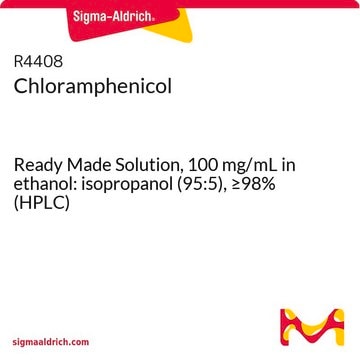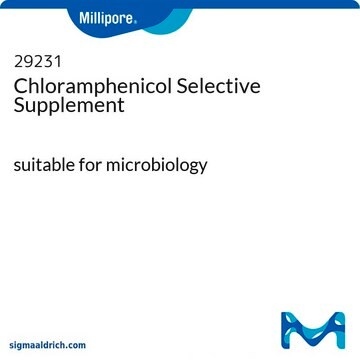C0378
Chloramphenicol
≥98% (HPLC)
Sinónimos:
D-(−)-threo-2,2-Dichloro-N-[β-hydroxy-α-(hydroxymethyl)-β-(4-nitrophenyl)ethyl]acetamide, D-(−)-threo-2-Dichloroacetamido-1-(4-nitrophenyl)-1,3-propanediol, D-threo-2,2-Dichloro-N-[β-hydroxy-α-(hydroxymethyl)-4-nitrophenethyl]acetamide, Chloromycetin
About This Item
Productos recomendados
assay
≥98% (HPLC)
form
powder or crystals
pKa
5.5
mp
149-153 °C (lit.)
antibiotic activity spectrum
Gram-negative bacteria
Gram-positive bacteria
mycobacteria
mycoplasma
mode of action
protein synthesis | interferes
storage temp.
room temp
SMILES string
OC[C@@H](NC(=O)C(Cl)Cl)[C@H](O)c1ccc(cc1)[N+]([O-])=O
InChI
1S/C11H12Cl2N2O5/c12-10(13)11(18)14-8(5-16)9(17)6-1-3-7(4-2-6)15(19)20/h1-4,8-10,16-17H,5H2,(H,14,18)/t8-,9-/m1/s1
InChI key
WIIZWVCIJKGZOK-RKDXNWHRSA-N
Gene Information
human ... CYP1A2(1544)
¿Está buscando productos similares? Visita Guía de comparación de productos
Categorías relacionadas
General description
Application
Chloramphenicol has been used as a bacteriostatic non potent antibiotic. It has been used for the selection/growth of positive bacterial cells.
Biochem/physiol Actions
Modo de resistencia: Acetilación por cloranfenicol-acetiltransferasa (gen cat).
Caution
Preparation Note
Other Notes
signalword
Danger
hcodes
Hazard Classifications
Carc. 2 - Eye Dam. 1 - Repr. 2
Storage Class
11 - Combustible Solids
wgk_germany
WGK 3
ppe
Eyeshields, Faceshields, Gloves, type P3 (EN 143) respirator cartridges
Certificados de análisis (COA)
Busque Certificados de análisis (COA) introduciendo el número de lote del producto. Los números de lote se encuentran en la etiqueta del producto después de las palabras «Lot» o «Batch»
¿Ya tiene este producto?
Encuentre la documentación para los productos que ha comprado recientemente en la Biblioteca de documentos.
Los clientes también vieron
Protocolos
To measure chloramphenicol acetyltransferase activity, this procedure uses DTNB and coenzyme A. The reaction of DTNB with the –SH group on CoA results in a colorimetric increase at 412 nm.
To measure chloramphenicol acetyltransferase activity, this procedure uses DTNB and coenzyme A. The reaction of DTNB with the –SH group on CoA results in a colorimetric increase at 412 nm.
To measure chloramphenicol acetyltransferase activity, this procedure uses DTNB and coenzyme A. The reaction of DTNB with the –SH group on CoA results in a colorimetric increase at 412 nm.
To measure chloramphenicol acetyltransferase activity, this procedure uses DTNB and coenzyme A. The reaction of DTNB with the –SH group on CoA results in a colorimetric increase at 412 nm.
Nuestro equipo de científicos tiene experiencia en todas las áreas de investigación: Ciencias de la vida, Ciencia de los materiales, Síntesis química, Cromatografía, Analítica y muchas otras.
Póngase en contacto con el Servicio técnico









